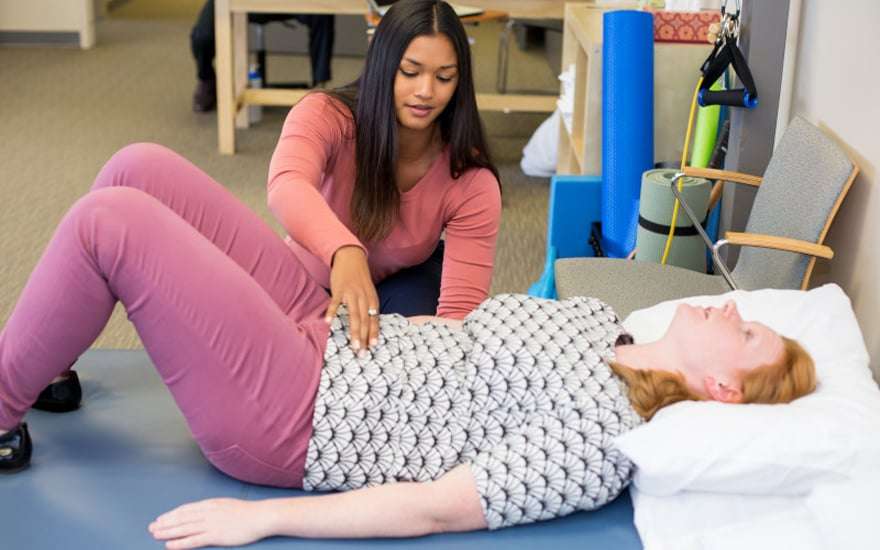What Is Urinary Incontinence?
Urinary incontinence is any undesired leakage of urine. A person with the condition also may have trouble starting the urine stream or holding urine. Urinary incontinence involves the muscles of the pelvic floor. These muscles attach to the bottom of the pelvic bones. They run from front to back and create the base of your core (torso, between the pelvic floor and diaphragm). They form a hammock structure that lifts and supports the internal organs. The pelvic floor muscles also:
- Control the sphincter muscles (ringlike muscles that open and close certain body openings).
- Support the low back.
- Stabilize the pelvic bones.
- Help with sexual function.
Women may be more likely than men to have urinary incontinence. However, men may underreport the condition.
Different types of urinary incontinence include stress, urge, mixed, and functional incontinence, as well as urinary frequency.
Stress Incontinence
The pelvic floor muscles and urogenital diaphragm (fibrous and muscle structures below the diaphragm) surround the urethra (the tube through which urine leaves the body). They help keep it closed when pressure is placed on the bladder. Stress incontinence occurs when these structures are weak or fail to support the urethra. Leakage happens when movement or physical activity puts excess pressure on the bladder. It can occur with:
- Laughing, sneezing, or coughing.
- Physical activity or exercise such as running.
- Activities such as lifting.
Women with stress incontinence often have pelvic floor muscle dysfunction due to:
- Pregnancy and childbirth, which put stress or pressure on the bladder or cause trauma to the pelvic floor muscles.
- Episiotomy (a procedure often used to ease childbirth).
- Perineal injury or tearing during childbirth.
- Injury or trauma, such as a pelvic fracture.
- Inflammation, such as cystitis.
- Surgery in the vagina or rectum.
- Lack of exercise or a lifestyle that involves too much sitting.
Urge Incontinence
This is a sudden, strong need to pass urine. People with this type of incontinence often experience a leak before reaching the bathroom. A strong coordinated contraction of the pelvic floor muscles helps decrease the urge to urinate. It also helps to keep the urethra closed. People with urge incontinence may lack this control due to pelvic floor weakness or tightness. Or they may experience spasms that contribute to bladder contractions. Conditions such as anxiety may increase the urge to empty the bladder.
Urge incontinence also can be learned. This is also known as “just-in-case” voiding. For example, someone who always urinates upon arriving home can begin to associate this with a need to go. Over time, they may feel this urge on the way home. This high-urgency feeling may lead to incontinence.
Caffeine and sugar, acidic foods, and smoking can irritate the bladder. These can lead to inflammation or cause the bladder muscle (detrusor) to contract more. This contraction can contribute to incontinence.
Mixed Incontinence
Some people experience both stress and urge incontinence.
Functional Incontinence
Leakage not directly related to the bladder or pelvic floor muscles is called functional incontinence. This type of incontinence results from problems other than weak pelvic floor muscles or bladder control. It happens when external factors, such as using a walker or crutches that slow movement, prevent a person from reaching the toilet in time. Even without a strong urge to urinate, people may leak urine on the way to the bathroom. The causes of functional incontinence include:
- Joint pain or muscle weakness (including low core, pelvic, or hip pain) that makes it hard to move.
- Confusion, dementia, or delirium.
- Depression or anger.
- Slow movement or mobility (such as when using a walker).
- Barriers or obstacles that block easy access to a bathroom (such as rugs or furniture).
Urinary Frequency
A person with an overactive bladder feels the need to empty it often during the day. They also may get up more than once at night to urinate. It may be caused by infection or other conditions that affect the urinary tract (kidneys, bladder, and the tubes or ducts through which urine flows). Being sensitive to certain foods or drinks also can contribute to urinary frequency.
Whether you’re male or female, physical therapy and pelvic floor exercises can fix your bladder control issues.
Posted by Featured Provider Kelly Brown Gross on Tuesday, February 18, 2020
Childbirth. Abdominal weakness. Diabetes. Prostate problems. There’s a long list of factors that can cause incontinence in women and men.
It’s a subject that’s very uncomfortable for people to talk about — even with a healthcare provider. But urinary incontinence is a widespread condition that, in most cases, can be cured with proper diagnosis and treatment. And treatment could be as easy as some exercises.
Urinary incontinence affects both women and men.
Incontinence affects women twice as much as men. But overactive bladder, bladder leakage and related issues can happen to anyone.
The most common cause of incontinence is trauma to the pelvic floor muscles. For women, that can happen after childbirth or even pregnancy. Also, menopause is a big factor for women because you lose some muscle mass. Men are more likely to develop urinary incontinence after having their prostate removed due to prostate cancer.
There are several different types of urinary incontinence. Stress incontinence and urge incontinence are the most common.
Stress Incontinence
Any leakage of urine that’s preceded by increased pressure in your abdomen is due to stress incontinence. It could be a cough or a sneeze. Lifting something heavy, jumping and other physical activities can all lead to leaking urine if you have stress incontinence.
Urge Incontinence
Urge incontinence happens when there’s a muscle spasm or some sort of dysfunction in your bladder that causes a strong, sudden urge to urinate. Before you’re able to get to a toilet, you leak some urine.
Mixed Incontinence
When you leak from both stressors and urges, you have mixed urinary incontinence. Women especially are likely to have a mix of bladder control problems causing their incontinence.
Incontinence isn’t the only bladder problem men and women face.
Urinary incontinence is a pretty obvious problem. Leakage is hard to miss. Two other common bladder issues may not seem like bigger health problems: urgency and frequency.
Urinary Urgency
You gotta go. And you gotta go right now. Urinary urgency is a strong, sudden urge to use the bathroom. You don’t get any warning and, all of a sudden, you have to run off to the restroom.
Urgency alone is a real bladder problem. When you have leakage along with it, that’s urge incontinence.
Frequent Urination
Frequency just means how often you’re going to the bathroom to urinate. Going anywhere between four and six — even up to eight times — in 24 hours is normal frequency. At night, you should be able to sleep through the night and get a good, solid eight hours without having to get up. But occasionally, you might have to get up once to pee.
If you’re within those ranges, it’s a signal of good bladder health. If you wake up more than once a night or are urinating more often than every two hours, that’s high frequency.
 Physical therapy can cure your bladder control issues.
Physical therapy can cure your bladder control issues.
Physical therapy is a conservative treatment for urinary incontinence and other bladder issues. But it’s so much more than muscle strengthening. Muscle weakness may be a contributing cause to your problem, but most of the time it’s more about coordination and muscle imbalance. You may also have incorrect posture or tight, overly active muscles.
A physical therapist can figure out the underlying causes of your bladder problems. Our featured Physical Therapist, Kelly Brown Goss, is rated in the Top 4% in the nation for pelvic floor outcomes as ranked by Focus On Therapeutic Outcomes, Inc. (FOTO). You may benefit from relaxation techniques, behavior modification or bladder retraining exercises, especially if you have an overactive bladder or urge incontinence. You may need to strengthen your core, improve your posture or exercise muscles you didn’t even know you had!
The muscles around your hips and pelvis are very close in proximity to the pelvic floor — the muscles that actually control the flow of urine. You can actually get some carryover by strengthening your hips and pelvis.
The pelvic floor muscles themselves are deeper and harder to target through traditional strength training. Strengthening them isn’t as easy as picking up some weights. But doing pelvic floor exercises can help tone these muscles and prevent urinary incontinence. That’s done primarily with Kegels, and then combined with better coordination of the deep muscles that make up your inner core.
How to Do Kegel Exercises Correctly
A Kegel is an active contraction of the pelvic floor and, if done regularly, can help you build stronger, thicker pelvic floor muscles. Despite different anatomy, Kegel exercises are the same for men as they are for women.
First, you have to find these muscles. Try stopping urination in midstream or holding back gas. That’s your pelvic floor at work. Then, lie down and repeat that movement to do a proper Kegel:
- Squeeze and lift up your pelvic floor.
- Hold the contraction for three seconds.
- Relax your pelvic floor muscles fully for three seconds.
It’s easiest to lie down at first but you can do Kegels anytime and anywhere, whether you’re cooking a meal or sitting at the office. So, it should be easy to work two to three sets of 10 repetitions into your day. As your pelvic floor muscles get stronger, hold the contraction for longer until you’re able to do so for 10 seconds.
How to Coordinate Your Inner Core Muscles
Once you’ve found your pelvic floor muscles and are able to activate them properly, it’s time to coordinate them with the rest of the inner core muscles. All of these muscles work together to manage pressure in your abdomen. And it all starts with diaphragmatic breathing, as the diaphragm and deep abdominal muscle are the other muscles that make up the inner core.
- While lying down, take a breath in, focusing on a gentle expansion of your lower ribcage and abdomen. As you do this, gently ‘let go’ of your Kegel.
- On the exhale, gently squeeze and lift your pelvic floor muscles as your abdomen and lower ribcage draw back in.
- Keep your breathing relaxed and quiet, making sure not to over engage the abdominal muscles.
With a regular routine of Kegels and diaphragmatic breathing, you can see results in a few weeks or months. And once you’ve mastered the contraction and coordination of your inner core, you can stop leakage from an unexpected urge or sudden sneeze.
Unfortunately, it’s not all cut and dried for everyone. Maybe you’ve tried Kegels and your symptoms haven’t improved or have gotten worse. Or you might not be completely cured of your incontinence and bladder issues.
If that’s the case, Kegels are probably not what your body needs and are not recommended. But other forms of pelvic physical therapy can help. Get an evaluation from a pelvic floor physical therapist to help you determine the proper exercises for your body. In 95 percent of the cases, a combination of pelvic floor physical therapy and Kegels makes a big difference, and you’re on your way to better bladder control.




